The Islamic Military Alliance (IMAFT) that was given support by Donald Trump in Saudi Arabia on May 21st, is not only a direct security threat to the European Union, as explained in my previous text, but also a disruption of regional balance. This is very evident in the current crisis around Qatar where Saudi Arabia tries to enforce its hegemony in the region.
The IMAFT alliance was officially founded to fight terrorism. So far, its only active military involvements were the military intervention to Yemen and the fight on the Qatar-Muslim Brotherhood alliance, instead of real fight on terror. It can be assumed that in mid-term, this military alliance can be used to promote interests of the Muslim countries in their neighborhood, under the leadership of the Wahhabi Saudi Arabia.
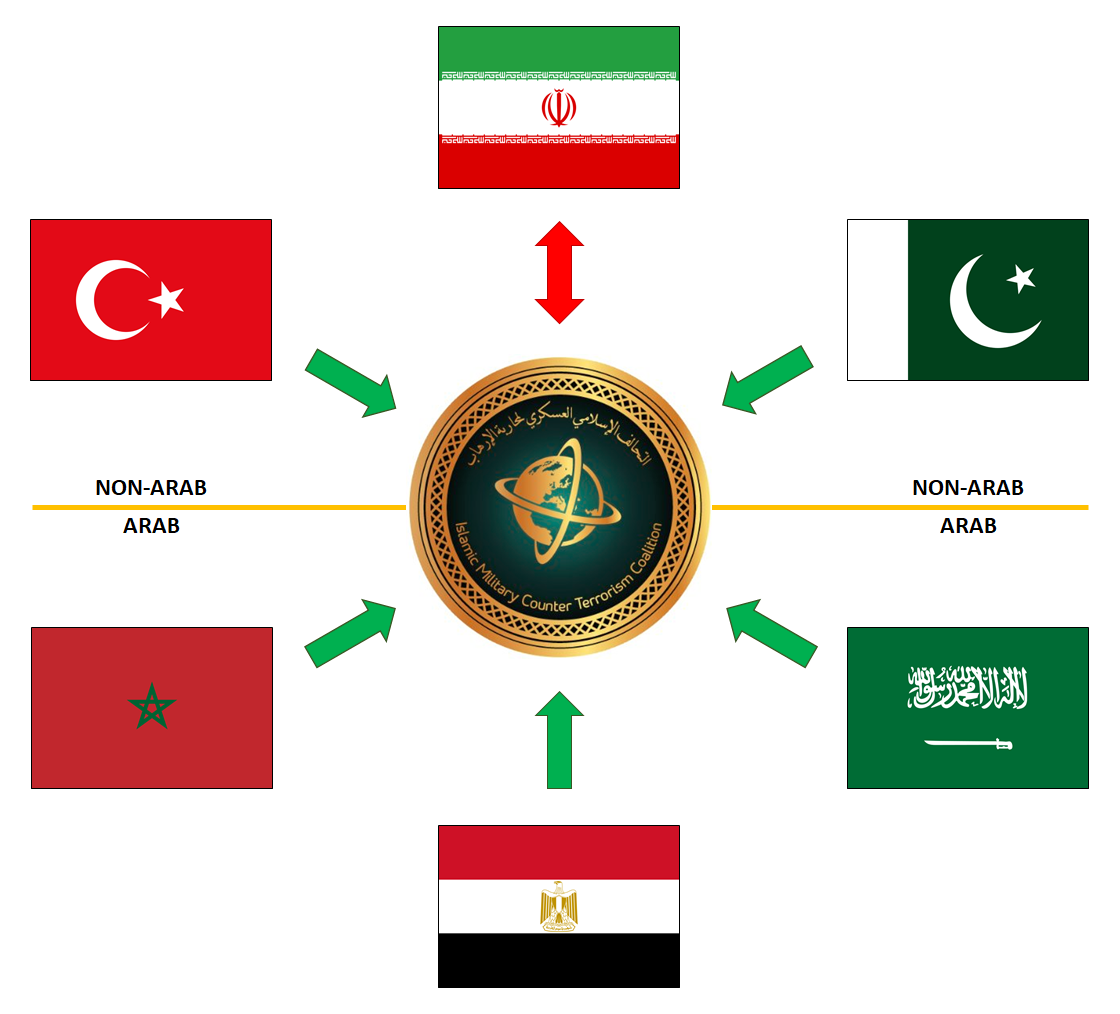
Main Arab powers (from southwest to southeast: Morocco, Egypt, Saudi Arabia) vs main non-Arab Muslim powers (from northwest to northeast: Turkey, Iran, Pakistan). IMAFT breaking this regional balance towards the “All vs Iran” formula
When one imagines the Greater Middle East as the MENACA region (Middle East-North Africa-Central Asia) between the Atlantic Ocean and India, and between Sahara and Siberia, respectively, it contains (in addition to Israel) 30 Muslim countries: 19 Arab-speaking states, 6 Turkic-speaking and 3 Persian-speaking countries, plus an Urdu-speaking Pakistan and the emerging Iraqi (+ Syrian) Kurdistan.
The Arab states are located in the heart of Islam, the Arabic is its holy language and the Arabs have a natural ambition to be a leader of the global Islamic umma. However, the most populous Islamic countries emerging since decolonization have not been the Arab states (with the exception of Egypt) but Indonesia, Pakistan, Bangladesh, Iran, Turkey and, partially, Nigeria. This situation and predominance of nationalism over Islamism became a natural barrier against spread of Pan-Islamism.
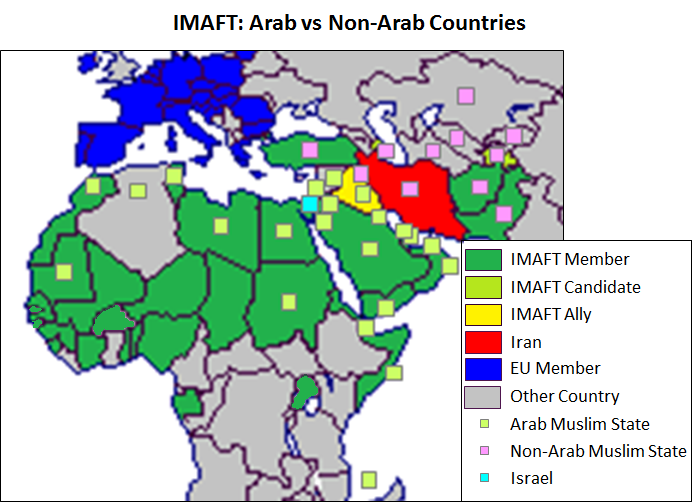
IMAFT vs the regional stability in the Middle East: Arab vs the Non-Arab Muslim countries
The ISIL and al-Qaeda leaders dreamed of a unified Islamic country – the Caliphate. However, IMAFT is building something much more dangerous than a dream: a united Islamic bloc led by the Wahhabi Saudi Arabia, the main exporter of radical Islamism all over the world. Such a bloc is a threat to regional stability in western Eurasia and in Africa.
A united Islamic power bloc under an Arab leadership does not seem to be a threat to distant America and its president. Even the current migration crisis threatening Europe does not pose any threat to the USA. But at this point, the European and the American interests are diverging.
No one has the right to prevent the Arab states from their mid-term integration. However, the existence of the three non-Arab Muslim regional powers, Turkey, Iran and Pakistan as a bridge between Europe and India plays the role of a natural barrier against emergence of an Arab-dominated Pan-Islamic state.
An alliance between Turkey, Iran and Pakistan, and thus creation of an Arab/non-Arab balance of power is the natural interest of the EU on its southern border. But IMAFT disrupts this natural balance as it subordinates Turkey, Pakistan and Afghanistan under Arab domination. Furthermore, non-Arabic Azerbaijan and Tajikistan are also invited to become IMAFT members while emerging Iraqi Kurdistan was represented at the summit by the Iraqi President of Kurdish descent.
IMAFT builds an Arab-dominated Pan-Islamic structure on the southern border of Europe and poses an unambiguous threat to the EU.
As President Trump emphasized in his speech, encirclement and containment of Iran is the main raison d‘être of IMAFT. Since signing of the JCPOA nuclear deal with the P5+1 powers, Iran became a new partner to the West. Of Iran opening up, with a significant part of its population having a very positive attitude towards the West, Trump is making an international pariah again.
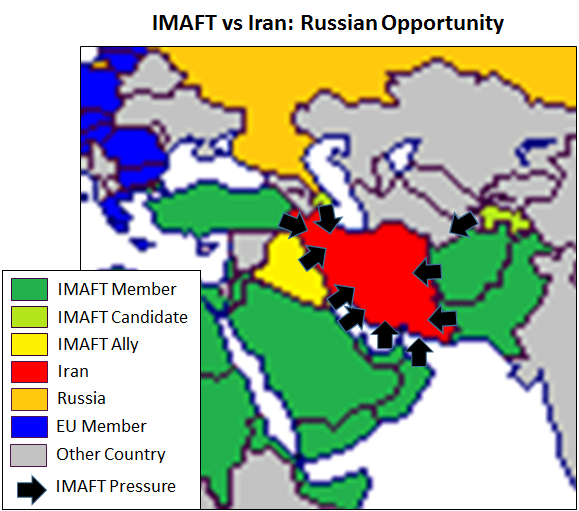
Pressure of the IMAFT members on Iran that is pushed to the arms of Russia
It reminds the situation after occupation of Afghanistan and Iraq by President Bush Jr. Then, Iranians being pushed into the corner, elected the radical Islamist Ahmadinejad after two terms of the reformist President Khatami.
Instead of a partnership that is the objective of the Iranian leadership, Trump drives Iran into the arms of Russia and to even greater insurgent support for its Shi’a fellowmen abroad. Shi’a of Yemen, Lebanon, Iraq, Syria and Afghanistan are not being appreciated for their traditional fight against the Sunni extremists of Al-Qaeda and ISIL. Thanks to a new isolation of Iran by the USA and IMAFT, Russia is being encouraged to put down its roots in the Middle East and the Mediterranean.
In the last years, Russia has systematically bombed the Sunni cities, being the opposition strongholds against the Syrian dictator Assad. Subsequently, the victims of the Russian bombing contributed the main share of the recent Syrian refugee wave to Europe. Russia is also a close ally of the Egyptian regime of Marshall Sisi. His Libyan proxy, Field Marshall Haftar, governs some crucial hubs of human trafficking to Europe via Libya.
Thus after Ukraine, Russia opened-up another front on the Middle East to disintegrate the European Union. For Europeans, such a Russian expansion southward is another threat.
The total expulsion of the ISIL from its largest city Mosul is imminent. The Iraqi military cooperate there with the US troops and the pro-Iranian militia. Currently, return of the US forces to Iraq is being considered in some circles.
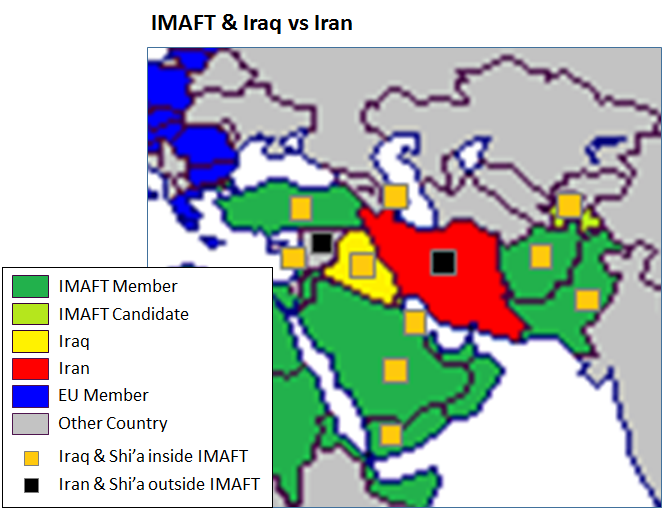
Potential Iraq vs Iran competition for the leadership in the Shi’a world; potential clients of Iran vs Iraq
By excommunication of Iran while inviting the Iraqi and Azerbaijani leaders to the summit, Trump sent a clear message that he would try to make Iraq, the land of the holiest Shi’a shrines (Najaf and Karbala), a counterweight to Iran and a leader of the Shi’a in opposition to Iran.
The power adventures of the Arab leaders, such as Saddam Husein and Ibrahim Maliki of Iraq, Haffez and Bashar Assad of Syria or Muammar Qaddafi of Libya proved that concentrating the leadership in the hands of minor Arab states is very dangerous.
Unlike Nasser, Sadat, Mubarak or Sisi of Egypt or the Iranian leaders after Khomeini’s death, those regimes did not excel in wisdom and moderation more typical to the global or regional powers. If Iraq plays the leadership role of the Shi’a, another destabilization of the region and another refugee wave to Europe can be expected.
The Shi’a world consists primarily of the four countries with a Shi’a majority: a Persian-speaking Iran, a Turcophone Azerbaijan, and Arabic-speaking Iraq and Bahrain.
Significant Shi’a minority regions include northern and central Yemen; southern Lebanon and the Beqa’a Valley; “Alawistan“ in northwestern Syria; cities of Hufuf and Qatif in eastern and Najran region in southern Saudi Arabia and the eastern governorates of Asir and Jizan regions on the Saudi south, as well as the Anatolia-Mesopotamia frontier in central-eastern Turkey.
Other Shi’a regions include Hazarajat in central Afghanistan and the Shughnan-Zebak-Wakhan area on the northeast; Gilgit-Baltistan province in northern Pakistan and the tribal Kurram agency of FATA, northern parts of Pakistani Sindh state and the Zikri areas of southern Baluchistan; Kargil and Sankoo tehsils of Indian Jammu and Kashmir state; and Gorno-Badakhshan in eastern Tajikistan.
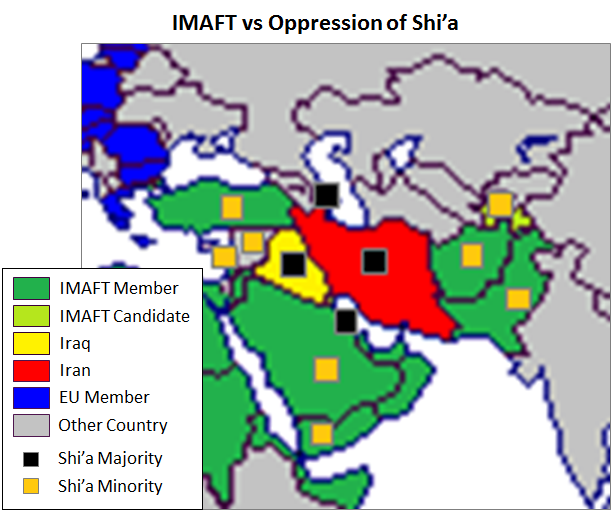
IMAFT and the oppression of the Shi’a in the Muslim world; Shi’a majority and Shi’a minority countries
The Shi’a are under pressure by the Sunni regimes in all those places with only minor exceptions. In Bahrain, the majority Shi’a are oppressed by the Sunni regime under Saudi protection. In an originally Shi’a al-Ahsa region of Saudi Arabia, the oil producing agglomeration of Dammam with three million inhabitants, mostly immigrants from the Sunni areas, has emerged, shifting the Eastern Region to a Sunni majority.
In the Shi’a regions of Yemen and Azerbaijan, Wahhabism is expanding with an active support of Saudi Arabia. ISIL engaged in violent conversions of the Shi’a Turcoman in northern Iraq while Taliban committed a genocide on the Shi’a Hazara in central Afghanistan.
After the end of the Cold War, several minority regimes ruled in the Arab World: Saddam’s Sunni regime in a predominantly Shi’a Iraq; the Sunni monarchy in Shi’a Bahrain, Assad’s Shi’a regime in a mostly Sunni Syria or Saleh’s Shi’a regime in a predominantly Sunni Yemen.
As those regimes used the ruling minorities to build the backbone of the privileged middle class, their eventual fall was followed by an oppression from the majority population. Former privileged minorities were pushed out of any share in power by the mathematics of a multiparty system. It was followed by a society-wide decline of the countries concerned and those minorities were forced to join the extremists: Iraqi Sunni the ISIL while Yemeni Shi’a the Houthi. A similar scenario is relevant for the Syrian Shi’a in case of an eventual overthrow of the Assad regime.
If a Sunni alliance against Iran is built by IMAFT, the Sunni regimes can consider their Shi’a population a fifth column. Lessons should be learned from the century old genocide of Christian Armenians and Assyrians in the Ottoman Empire fighting against Christian Russia.
Active participation of Turkey, Yemen, Lebanon, Pakistan and Afghanistan (and an invitation for Tajikistan) in the alliance against Iran poses a threat of even worse oppression of the Shi’a minorities in those countries, not to mention Saudi Arabia. In turn, the oppression of the Shi’a represents a threat of another refugee wave to Europe.
Instead of fight on terror, the Islamic Military Alliance (IMAFT) has focused on a sectarian fight against Iran and its Shi’a allies in Yemen. Although this may seem as an innocent effort to imitate the NATO from remote American perspective, from the point of view of the European Union it is a dangerous alliance.
IMAFT is a potential direct threat the EU by military and economic means (huge military budget, militarization of the OPEC), as described in the previous text “Trump jeopardizes security of the EU in Riyadh“. In addition to that, IMAFT subordinates the non-Arab regional powers Turkey and Pakistan under the Saudi leadership, destroying the balance of power in the Middle East.
By its anti-Iran focus, it drives Iran to the arms of Russia and it gives Russia an excuse for its expansion to the region. Its effort to install Iraq a leader of the Shi’a world also threatens the stability in the Middle East. And, finally, the alliance creates a risk of even harder oppression of the Shi’a minorities and another migration wave to Europe.